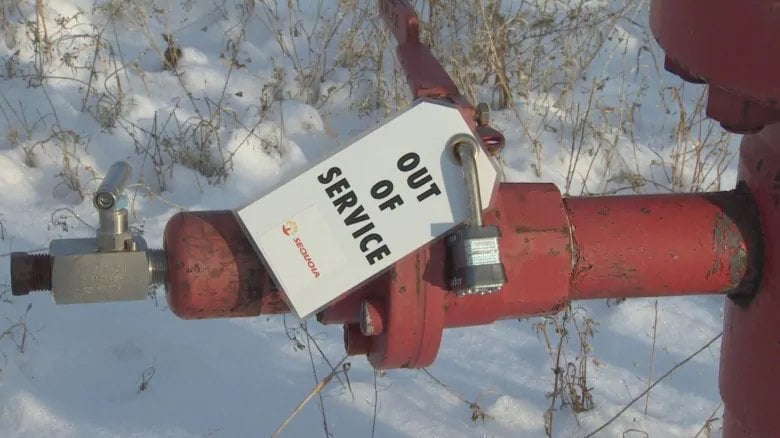Low Oil Levies Leave Alberta Facing A Growing Orphan Well Problem

Table of Contents
The Impact of Low Oil Levies on Orphan Well Remediation
Low oil levies have directly contributed to the escalating orphan well problem in Alberta, creating a perfect storm of financial constraints and environmental risks.
Reduced Funding for Orphan Well Programs
Insufficient funding is the most immediate and pressing issue. Low oil levies translate directly into decreased funding for crucial orphan well programs. This results in:
- Decreased funding for the Orphan Well Association (OWA): The OWA, responsible for much of the cleanup, struggles to meet its obligations with limited resources.
- Delays in site assessment and remediation: The backlog of sites requiring attention continues to grow, delaying essential cleanup and increasing risks.
- Increased backlog of orphan wells: The number of abandoned wells awaiting remediation is increasing exponentially, creating a ticking environmental time bomb.
Recent reports indicate a 25% budget cut to the OWA in the last fiscal year, directly correlating with a 15% increase in the number of reported orphan wells. This unsustainable trend necessitates immediate action.
The Financial Burden on Taxpayers
The cost of orphan well remediation is substantial and only grows with time. Delaying action now will lead to exponentially higher costs in the future, ultimately shifting the burden onto Alberta taxpayers:
- Rising remediation costs over time: The longer remediation is delayed, the more expensive and complex the cleanup process becomes.
- Potential for increased taxes to cover cleanup: The massive cost of cleaning up neglected wells will inevitably necessitate increased taxes or other fiscal measures.
- The long-term economic implications of inaction: This financial burden will stifle economic growth and divert funds from other essential public services.
Ignoring this mounting debt is fiscally irresponsible and threatens Alberta's economic future.
Attracting Investment and Energy Sector Confidence
The orphan well problem significantly impacts Alberta's ability to attract investment and maintain the confidence of the energy sector:
- Investor concerns about environmental liabilities: Potential investors are hesitant to commit to projects in a province with a significant environmental liability like this.
- Difficulty attracting new energy projects: The perception of environmental risk deters investment in new energy exploration and development.
- Negative impact on Alberta's economic outlook: This reputational damage undermines Alberta’s competitiveness in the global energy market.
Environmental Consequences of Unremediated Orphan Wells
The environmental consequences of leaving orphan wells unremediated are severe and far-reaching.
Threats to Water Resources
Abandoned wells pose a direct threat to both surface and groundwater resources:
- Leakage of produced water: Contaminated water from abandoned wells can leach into groundwater supplies, contaminating drinking water sources.
- Migration of contaminants: Harmful chemicals and heavy metals can migrate through the soil and contaminate nearby water bodies.
- Impact on drinking water supplies: Contaminated water sources pose serious health risks to both humans and wildlife.
The potential for widespread water contamination is a critical concern that demands immediate attention.
Greenhouse Gas Emissions
Unremediated wells contribute significantly to greenhouse gas emissions:
- Methane's potent global warming potential: Methane leaking from abandoned wells is a potent greenhouse gas, far exceeding the warming potential of carbon dioxide.
- Contribution to climate change: These emissions exacerbate climate change, impacting Alberta and the global environment.
- The need for sustainable remediation strategies: Developing and implementing sustainable remediation methods is crucial for mitigating these emissions.
Addressing methane leakage from orphan wells is critical for meeting climate change goals.
Habitat Degradation and Biodiversity Loss
Abandoned well sites significantly impact wildlife and ecosystems:
- Loss of habitat: Well sites disrupt natural habitats, affecting wildlife populations.
- Disruption of wildlife migration patterns: Well sites can create barriers to animal movement, fragmenting habitats.
- Threat to endangered species: Some species are particularly vulnerable to habitat loss and disruption caused by abandoned wells.
Protecting biodiversity requires urgent action to remediate these sites and restore affected ecosystems.
Potential Solutions and Policy Recommendations
Addressing the growing orphan well problem requires a multifaceted approach that includes policy changes, technological innovation, and increased funding.
Increasing Oil Levies
Raising oil levies is a necessary step to provide adequate funding for remediation programs:
- The need for sustainable funding mechanisms: A dedicated and stable funding source is essential to tackle the existing backlog and prevent future orphan wells.
- Potential for phased increases: A phased approach to levy increases can minimize economic disruption while ensuring adequate funding.
- Public consultation and transparency: Open and transparent communication with the public is crucial to ensure public support for increased levies.
Improving Regulatory Frameworks
Strengthening regulations is crucial to prevent the creation of new orphan wells:
- Strengthening liability requirements: Clearer liability frameworks ensure responsible parties are held accountable for well decommissioning.
- Enhancing well site monitoring: Regular inspections and monitoring of active wells can identify potential problems early.
- Promoting responsible well decommissioning practices: Incentivizing and mandating responsible decommissioning procedures can significantly reduce the number of orphan wells.
Investing in Innovative Remediation Technologies
Investing in research and development of innovative technologies can improve remediation efficiency and reduce costs:
- Research and development funding: Increased funding for research into more effective and cost-efficient remediation methods is crucial.
- Pilot projects for new technologies: Testing and implementing new technologies on a pilot scale can demonstrate their effectiveness and potential.
- Collaboration with industry and academia: Collaboration between government, industry, and research institutions can accelerate innovation and technological advancements.
Conclusion: Addressing the Growing Orphan Well Problem in Alberta
The growing number of orphan wells in Alberta presents a significant environmental and economic challenge, directly linked to insufficient funding due to low oil levies. Inaction will result in irreversible environmental damage, escalating remediation costs, and damage to Alberta’s reputation as a responsible energy producer. Addressing this orphan well problem requires immediate and decisive action. We must increase funding for remediation programs through higher oil levies, strengthen regulations to prevent the creation of new orphan wells, and invest in innovative technologies to improve cleanup efficiency. Demand action on the orphan well problem – contact your MLA today!

Featured Posts
-
 Liverpools Extra Wissels Tegen Southampton Een Duidelijke Verklaring
May 29, 2025
Liverpools Extra Wissels Tegen Southampton Een Duidelijke Verklaring
May 29, 2025 -
 The Bring Her Back Transformation A Behind The Scenes Look At Unforeseen Horror
May 29, 2025
The Bring Her Back Transformation A Behind The Scenes Look At Unforeseen Horror
May 29, 2025 -
 Heitingas Touchline Behavior Media Scrutiny Of A Unique Coaching Interaction
May 29, 2025
Heitingas Touchline Behavior Media Scrutiny Of A Unique Coaching Interaction
May 29, 2025 -
 Everything Going To Be Great Official Trailer Breakdown And Analysis
May 29, 2025
Everything Going To Be Great Official Trailer Breakdown And Analysis
May 29, 2025 -
 Real Zaragoza Vs Eibar Hoy En Vivo Y En Directo Por La Liga Hyper Motion
May 29, 2025
Real Zaragoza Vs Eibar Hoy En Vivo Y En Directo Por La Liga Hyper Motion
May 29, 2025
